Have you ever looked at an old sweater or a pair of jeans and thought, “This fabric is too lovely to throw away”? That’s the perfect start to learning how to sew stuffed animals with recycled materials for beginners. Making soft toys from old clothes and household fabrics isn’t just a creative hobby—it’s an eco-friendly way to give forgotten materials a new story. Even if you’re just starting out, you can create something adorable and personal with just a few tools and a bit of patience.

Why Make Stuffed Animals from Recycled Materials
There’s something heartwarming about turning worn-out fabrics into cozy handmade toys. It’s a small act of sustainability, and it feels wonderful knowing your creativity helps reduce waste. Plus, each recycled fabric carries a story: a favorite shirt becomes a cuddly bear, a child’s blanket transforms into a bunny, and even an old pair of jeans can turn into a sturdy toy dog.
These projects are inexpensive, meaningful, and surprisingly beginner-friendly. You don’t need to buy fancy materials—everything you need is probably already in your home.

Best Recycled Materials for Stuffed Animals
When selecting fabrics, focus on texture, stretch, and thickness. Cotton shirts, soft flannel, and old pillowcases are great because they’re easy to cut and sew.
Denim from old jeans is perfect for toys that need structure—it holds shape well and gives a slightly rustic look.

Felted wool from an old sweater makes for a warm, cozy finish, especially if you lightly wash it in hot water to make the fibers denser.
Here’s a quick guide that shows what works well and what doesn’t when sewing with recycled materials:
Material Type | Works Well For | Tips | Avoid If |
Cotton shirts or pillowcases | Soft animals, simple shapes | Easy to cut and sew, breathable | Fabric is too thin or worn out |
Denim (old jeans) | Structured toys, bears, dogs | Strong and durable, great for shape | The full toy will be hard to control |
Felted wool sweater | Cozy animals, winter toys | Dense texture, doesn’t fray | Too thick for small details |
Flannel or pajamas | Plush, cuddly toys | Feels soft, easy for beginners | Fabric has holes or pills |
Old towels or blankets | Large toys or pillows | Excellent for texture variety | Material sheds too much |
Stretchy jersey (T-shirts) | Quick projects | Use interfacing to prevent stretching | Too thin or overly stretchy |
Satin, silk, or slippery synthetics | Decorative parts only | Great for small accents | Full toy will be hard to control |
Simple Shapes and Easy Sewing Steps
Start with simple shapes—hearts, stars, bears, or cats are perfect. Draw your pattern directly on the fabric with chalk, pencil, or a washable pen. If you’re nervous about symmetry, fold your fabric in half before cutting; this ensures both sides match perfectly. Two pieces of fabric per toy are enough for your first try.
Pin them together with the right sides facing each other. Sew around the edge using a straight stitch, leaving a small opening at the bottom. Once the shape is sewn, gently turn it inside out and push out the corners with a pencil or knitting needle. Now it’s time to stuff your creation.

Add small handfuls of filling at a time and spread it evenly. When the toy feels firm but still soft, sew the opening closed using a ladder stitch or tiny invisible stitches.
If you want to add personality, stitch on simple features—a nose made of embroidery thread, two buttons for eyes, or a little fabric bow. Small details like this bring your toy to life.
What Works and What Doesn’t
Over the years, I’ve learned that some materials behave better than others. Denim, cotton, and wool blends are almost always successful. They’re sturdy and easy to handle, especially for hand sewing. However, jersey T-shirts can stretch unpredictably, and thin polyester tends to fray.
If you still want to use these trickier fabrics, iron on a piece of lightweight interfacing to strengthen them before cutting.

One of the most common beginner mistakes is overstuffing. It might seem tempting to fill the toy until it’s firm, but too much stuffing puts stress on seams and can make the shape look uneven. Another issue is sewing too close to the edge; try to keep your stitches about a quarter inch from the border.
That little allowance keeps seams strong and durable. And don’t worry about tiny imperfections—those uneven stitches or slightly crooked ears are part of what makes handmade toys so charming.
If your first toy doesn’t turn out perfect, don’t throw it away. Keep it as a reminder of how far you’ve come. Every crafter starts somewhere, and each piece you make teaches something new—about fabric, stitches, and patience.
Inspiration for Your First Projects
If you’re still unsure what to make, think about simple, heartfelt projects. A patchwork bunny made from different shirt sleeves, a denim bear stitched from an old pair of jeans, or a soft heart from a flannel pajama leg. These small projects are quick, satisfying, and make sweet gifts.
They’re also a wonderful way to keep memories alive—imagine turning a baby blanket into a little keepsake toy or reusing a beloved sweater to create a soft animal for someone special.

Once you finish your first toy, you’ll start seeing possibilities everywhere. Old fabrics stop being “trash” and become potential treasures. The process itself is relaxing and rewarding, especially when you realize that you can make something adorable entirely from materials you already have.

Learning how to sew stuffed animals with recycled materials for beginners isn’t about perfection—it’s about creativity, sustainability, and joy.
Each stitch tells a story, and each toy becomes a tiny symbol of care for both the planet and the people you make it for. Grab your scissors, rescue a forgotten fabric from the closet, and start your next little adventure in sewing today.
Frequently Asked Questions
What recycled materials are best for stuffed animals?
Cotton, denim, and felted wool are beginner-friendly. They hold their shape, sew easily, and give a professional look. Avoid fabrics that are too thin, slippery, or stretchy.
Can I make stuffed animals by hand without a sewing machine?
Absolutely! Hand sewing works beautifully for small toys. A simple running stitch or backstitch is strong enough for most projects.
What can I use instead of toy stuffing?
You can use scraps of old fabric, pieces of fleece, or filling from an old pillow. Just make sure it’s clean and soft.
How do I clean recycled fabrics before sewing?
Wash and dry them according to the original fabric type. Iron them flat so it’s easier to cut patterns. For old wool sweaters, hot water helps felt the material, making it thicker and sturdier.
Can beginners really make cute toys from recycled materials?
Yes! Start small, pick easy fabrics, and enjoy the process. Each toy you make will improve your skills and confidence.
Get Free Patterns & Be the First to Know!
Want free teddy bear patterns, exclusive tutorials, and a chance to win craft supplies?
Sign up for our newsletter using the subscribe form in the middle of this article to receive new patterns, insider tips, and the latest news on teddy bear art. You’ll also automatically be entered into our annual giveaway for a chance to win teddy bear crafting materials.
Bonus entry: Save one of our pins on Pinterest to increase your chances of winning!
Let’s create, inspire, and craft beautiful teddy bears together!


Hanna, this is charming and practical. I love how you turn old fabric into stories kids can hold. I have repurposed shirts and pillowcases before, but your denim and felted wool tips make the shapes feel sturdier and more forgiving for beginners.
I would love to learn more about how you do your crafts. I would also like to say that I’ve been a reader now, a fan of your blog. I love your writing style and the way you break down points step-by-step in your clothes craft. It means a lot, even those who have no experience, can follow along.
One question: what do you prefer for strength?
John
Hi John!
Thank you so much — your message truly made my day! I love hearing that you’ve tried repurposing shirts and pillowcases — that’s such a beautiful way to give old fabrics new life. Denim and felted wool are definitely my go-tos when I want something that holds shape well but still feels soft and cozy.
For strength, I usually prefer a tightly woven cotton or lightweight denim for the body, and I reinforce seams with a double stitch — especially around the joints. Felted wool is also great because it doesn’t fray, so it’s forgiving for beginners and lasts a long time.
I’m so glad you’ve been enjoying the tutorials and my step-by-step guides. Thanks again for being part of the blog!
This is such a wonderful and inspiring tutorial! I love how you’ve combined creativity with sustainability, showing that crafting beautiful stuffed animals doesn’t require new materials. Your step-by-step instructions are so clear and approachable, making it feel achievable even for someone new to sewing.
The tip about using old sweaters for a soft, textured look is brilliant! Do you have any favorite types of fabric to upcycle, or any tricks for making sure the recycled materials are sturdy enough for play? Thank you for sharing such a thoughtful and eco-friendly project!
Thank you so much for your lovely comment! I’m pleased you enjoyed the tutorial and that the eco-friendly idea inspired you!
I especially love sewing with denim — it makes the toys look very stylish and modern. But honestly, I’ve tried almost every type of fabric. I also really like cotton — it’s natural, pleasant to work with, and keeps its shape nicely. The only material I don’t like is knit fabric — it stretches too much and can lose its neat look.
For extra strength, I use a double thread when sewing with regular thread, or a super-strong one if I have it — that way the toy is durable and long-lasting.
And one little tip: if you’re making toys for kids to play with, avoid adding small details like beads for eyes. It’s much safer to embroider the eyes or draw them with a non-toxic fabric marker. That way, your toy will be both adorable and safe.
Hi Hanna
Which pattern did you use for the Denim teddy bear featured in this article.
Hi Karen! Thank you for your comment. The teddy bear in the photo is meant as an inspirational example, not made from a specific pattern. You can use any classic teddy bear pattern and try making it from denim.
Thankyou..do you like to use a jointed bear pattern or non jointed for recycled fabrics?What works the best?
That’s a great question, Karen! Both jointed and non-jointed patterns work well with denim and sturdy cotton fabrics. For stretchy fabrics, it’s better to keep things simple — primitive-style bears without joints usually turn out best. The same goes for very thin cotton or linen fabrics. And I don’t recommend using slippery or synthetic materials for teddy bears at all — they’re just too tricky to work with.
If you’d like to learn more about different joint options, I have a detailed guide here https://teddybearart.com/simple-teddy-bear-sewing-pattern-limb-attachment-thread-and-buttons-vs-cotter-pins/
Every fabric has its own charm — the fun part is experimenting and seeing which one brings your teddy to life!